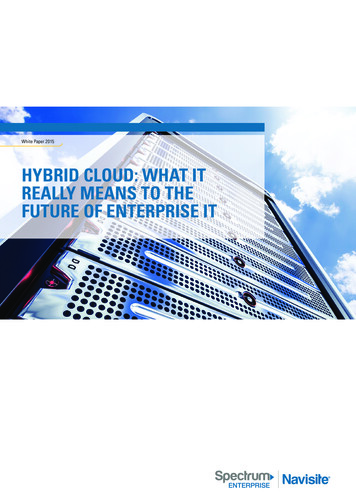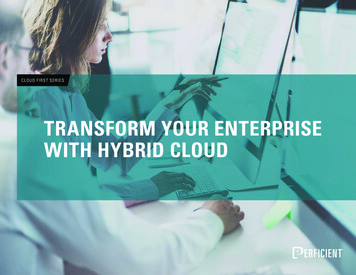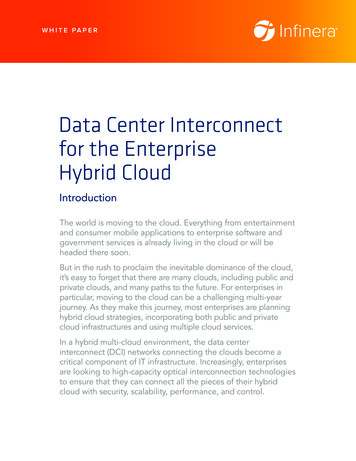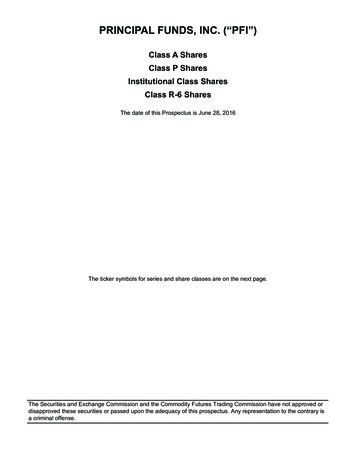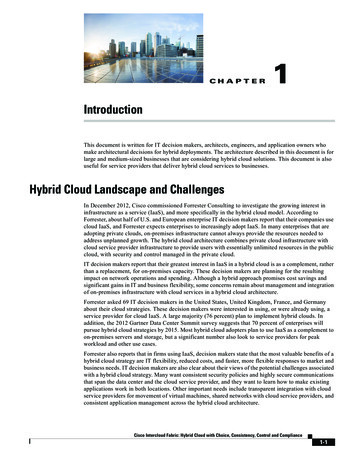
Transcription
in partnership withHybrid Cloud: TheFuture Ready ReferenceArchitecture for ModernBusiness.
Hybrid Cloud:FutureArchitectureDocumentTitleThegoeshere ReadySourceReferenceSans Pro Regular9pt for Modern BusinessGet future ready - Modernise nowNo industry was prepared for the disruptionCOVID-19 caused. Although some organisationswere able to act more quickly than others to supportremote workers and sustain business operations,even those wit sophisticated digital capabilities facedchallenges with scalability and interrupted supplychains.As a result, businesses across industries had toswiftly pivot to build new digital competencesif they wanted to not only survive but compete.Today, they’re accelerating digital transformationinitiatives despite economic uncertainty. They’removing beyond simply responding or adapting, toaccelerating innovation so they can seize any newopportunities that arise.And to achieve all this, they’re modernizing bothapps and infrastructure while moving to the cloud.App modernisation drives digitaltransformationApp modernization makes it possible for enterprisesto continuously change and improve applicationsat a pace that keeps up with their rapidly shiftingbusiness needs.This usually involves using container technology.Containers allow enterprise developers to deployapplications using portable, lightweight packaging.App modernization also includes using the cloud toachieve programmatic control of infrastructure, bothvirtually and remotely. It is the combination of bothpackaging and on-demand infrastructure servicesthat allow developers to use Agile developmentpractices and automated release processes toquickly and frequently update application features.Kubernetes is a popular choice for automatingdeployment to production and orchestratingcontainer run time at scale to achieve highavailability.dimensiondata.comIn combination,containers, cloud andKubernetes make itpossible for developersand IT work together tomeet digital businessrequirements.Cloud brings it all togetherModern apps require modern infrastructure. Andfor most organizations, that means adopting hybridcloud infrastructure. And it’s not just about efficiencyand scale; it’s about changing the way that IT servicesare delivered and consumed, with flexibility todeploy workloads where it makes sense from bothbusiness and technical requirements.This white paper explores how a hybrid cloudties together IT elements as a cost-efficient andproductive strategy. It provides a referencearchitecture detailing all of the necessary layers.With this information, your team can deliverstandardized, on-demand services that areplatform- and environment- ndependent, and deliverdeveloper-ready infrastructure services for all typesof applications to not only withstand whateverhappens next, but turn it into competitive advantage. Copyright Dimension Data 2
Document Title goes here Open Sans Pro Regular 9ptHybrid Cloud Reference ArchitectureHybrid cloud is the optimal model for modern business, and is the preferredenvironment for the vast majority of today’s IT organizations. According toEnterprise Strategy Group, 88 percent of enterprises currently have a hybridcloud environment—a number that will continue to rise in the next 12 to 24months.1Hybrid cloud is defined as a combination of on-premises data center, cloud,and edge IT environments that have been unified to support consistentoperations. It’s important to understand that cloud is an operating model thatcan utilize either public or private cloud infrastructure. Although 70 percent ofIT organizations recently surveyed are actively engaged in migrating existingapplications to public cloud, they are also planning to deploy nearly half (47percent) of their new cloud-native workloads to private cloud.2But the hybrid cloud infrastructure is just the beginning. You need othercapabilities layered on top of it: application operations, IT service delivery, andoperational efficiency.You need these to enable: Rapid application delivery and observability Flexible consumption of IT services Consistent operationsThe reference architecture in Figure 1 illustrates key capabilitiesdelivered by a singleplatform hybrid cloud solution.dimensiondata.com Copyright Dimension Data 31. Enterprise Strategy Group. “Exploring Hybrid Cloud Adoption and the Complexity of Securing East-West Traffic,” January 2020.2. Management Insight Technologies. “VMware Research Snapshot: The State of Application Modernization and Hybrid Cloud Computing,” January 2020. (N 1205)
Hybrid Cloud: The Future Ready Reference Architecture for Modern BusinessApplication delivery and observabilityConsistent operationsAt the top level of the reference architecture—theapplication operations level—your organization needsthe ability to swiftly make a broad spectrum of changes toapplication operations. Specifically, you need to be able to:At the operations layer of the hybrid cloud referencearchitecture, your organization can deploy a single cloudoperating model for securing, governing, and operatingthe entire hybrid cloud. This is where you benefit from thesignificant efficiencies of extending a single, proven modeleverywhere because you have: Rehost – Perform “as is” workload migration to thecloud without changing architecture or code Replatform – Be able to containerize traditionalworkloads to increase agility and standardizeautomated development and deployment tool chainsStandardized services – A single model for security,governing, and operating the entire hybrid cloud Refactor – Utilize cloud-native and microservicesarchitectures by rewriting or writing new code.Automated service delivery – Greater agility andproductivity, and the elimination of operationalbottlenecks created by legacy infrastructure Optimized infrastructure and resource utilization– The ability to get more out of your existinginvestments in teams, processes, policies, and skills byextending to the cloudFlexible consumptionAt the IT service delivery layer, your team needs to be ableto optimize infrastructure by leveraging the instant agilityand scale of public cloud providers while using familiartools and processes. This leads directly to: Self-service – Your developers and line-of-businessapplication owners can access resources from bothon-site and public cloud environments with the cloudself-service delivery capabilities and programmatic APIinterfaces they have come to expect.Strong governance – With hybrid cloud, you can linkpolicies to each application which ensures consistentadoption wherever workloads are deployed andmanaged.Reduced costs – Your organization can improveon-premises cloud capabilities and shift from siloedinfrastructure-oriented operations to a service-brokercapability that delivers the same interactions with IT,regardless of where applications are deployed. Thisdrives efficiencies of scale and thus lower costsdimensiondata.comConsistent infrastructureFinally, at the infrastructure layer, your organizationcan leverage a cloud operating model that is based on astandardized solution stack across multiple environments.No retraining or retooling required because the hybridcloud infrastructure is: Software-defined – Bringing siloed resources togetherinto a holistic, software-defined system allowsconsistent operations through a single managementinterface Automated and orchestrated – Streamlining andstandardizing service delivery makes IT both moreagile and efficient Flexible deployment – With options for on-premises,hosted provider, and public cloud— with softwaredefined and automated control of all underlyingresources Copyright Dimension Data 4
Hybrid Cloud: The FutureReady Referencefor ModernBusinessDocumentTitle goesArchitecturehere Open SansPro Regular9ptHybrid Cloud Supports Strategic IT InitiativesA single hybrid cloud operating model builds on existing, proven capabilities for supporting the most demandingand essential applications in the world. It also enables your organisation to tap into powerful emerging ITinnovations. Here are some ways that one platform for hybrid cloud can advance your strategic initiatives while alsoenabling your organisation to get the most out of your existing IT investments.Modernise your data center with cloudMassive opportunities still exist for your IT organisation to improve the capacity, efficiency, and operations ofyour on-premises data center(s). By extending proven virtualisation to storage and networking, and managinginfrastructure resources together (rather than in silos) your organisation can create complete software-defined datacenters that reduce IT complexity. Hyperconverged infrastructure (HCI) significantly improves resource efficiencyand makes resources more easily consumable. By adopting a hybrid cloud operating model, you quickly transformtraditional IT offerings into as-a-service ones through service blueprinting, self-service, and rich APIs for developers,further increasing IT agility.Tap into public cloudsAlthough cloud strategies initially involved migrating a target percentage of on-premises applications to the cloud,today’s hybrid cloud strategies are more nuanced. A hybrid cloud extends your cloud model to traditional IT,delivering: Pay-per-use pricing by linking on-going costs to operational expenses (OpEx) instead of capital expenses (CapEx At-scale service delivery for temporary but resource-intensive use cases Data center consolidation or evacuation App development in cloud, app production on premises Cross-environment disaster recoveryAutomate your service deliveryAutomated service delivery is the hallmark of cloud, reducing IT burdens and speeding your operations. With hybridcloud, you transform how IT services are consumed because automation streamlines and standardizes servicedelivery.Automate service consumption with developer-ready infrastructureWith hybrid cloud, your team can ensure developer-ready infrastructure can be automatically consumed as cloudservices as part of DevOps, Agile, and CI/CD methodologies. Additionally, you can enable abstraction and APIinterfaces for programmatic consumption of infrastructure services in a way that powers faster and more frequentdevelopment of new app features.Modernise your appsModernising infrastructure and applications accelerates the speed and ease of developing new apps as well asupdating existing ones. Through containers, your developers can deploy their applications with portable, lightweightpackaging while hybrid cloud gives them programmatic control of infrastructure both virtually and remotely. Thecombination of containers, cloud infrastructure, and integrated CI/CD, tools allows your developers to ship rapidincremental changes to applications to meet continuously changing business needsEmbed securityAlthough seamlessly scaling applications between data centers and cloud has immense advantages, securing hybridsolutions is increasingly complicated. And more so for organizations that try to secure applications by “bolting on”multiple point security products that solve niche problems. A future ready hybrid cloud embeds security intrinsicallyinto the infrastructure, enabling your IT organization to apply security policies that follow workloads, and are notlimited to infrastructure boundaries. This ensures your security policies scale with applications as they extend fromthe data center to the cloud or to the edge.dimensiondata.com Copyright Dimension Data 5
hereReadySourceReferenceSans Pro Regular9pt for Modern BusinessDimension Data and VMware CloudHybrid Cloud from Dimension Data and VMwareDimension Data and VMware hybrid cloud platform is built on fullstack hyperconverged infrastructure. It provides a complete set ofsecure, software-defined services for compute, storage, networksecurity, Kubernetes management, and cloud management. The resultis agile, reliable, and efficient cloud infrastructure that offers consistentinfrastructure and operations across private and public clouds.VMware Cloud Foundation with VMware Tanzu now integratesKubernetes to deliver infrastructure services for developers, andcluster management and container workload orchestration for ITadministrators. As a result, both virtual machine (VM) and containerworkloads are treated as first-class citizens, giving developers acompliant and conformant API interface, and IT administrators trustedand familiar tools and operating processes for systems management.Hybrid and Multi-CloudDimension Data and VMware have built some of the largest and mostsuccessful private and hybrid clouds in the world. Now, DimensionData and VMware is making hybrid cloud and multi-cloud a reality byintroducing Dimension Data and VMware Cloud on all major cloudprovider platforms.The same Dimension Data and VMware Cloud Foundation deployedin your data center is available as a Dimension Data managed serviceas Dimension Data and VMware Cloud on AWS. It is also offered bythe leading global hyperscalers as Google Cloud Dimension Data andVMware Engine, IBM Cloud for Dimension Data and VMware Solutions,Microsoft Azure Dimension Data and VMware solution, and OracleCloud Dimension Data and VMware Solution.Dimension Data andVMware Cloud delivers enterprise agility,reliability, and efficiency for clients who have private, hybrid, and multicloud strategiesdimensiondata.com Copyright Dimension Data 6
Hybrid Cloud: The FutureReady Referencefor ModernBusinessDocumentTitle goes Architecturehere Open SansPro Regular9ptDimension Data and VMware Hybrid Cloud ValueBy modernising both applications and infrastructure and by taking advantage of cloud capabilities - specifically the VMwarehybrid cloud via a single platform model—your enterprise can easy meet core IT priorities. These include agility, high servicequality, minimized costs, and robust governance and security.dimensiondata.com Copyright Dimension Data 7
Hybrid Cloud:FutureArchitectureDocumentTitleThegoeshere ReadySourceReferenceSans Pro Regular9pt for Modern BusinessRealise the value ofDimension Data andVMware Cloud today.Visibility into how yourworkloads impact eachotherThis online assessmentgives you visibility into howyour workloads impact eachother and helps optimiseyour IT environment forthe easiest and fastest pathtoward hyperconvergedinfrastructure (HCI) andhybrid cloud.Sign up now for your freeassessmentAdvantages of Dimension Data and VMwareCloudDimension Data and VMware Cloud is software-definedinfrastructure that helps to simplify your IT operationswhile also offering powerful capabilities to your storage andnetworking teams to secure and accelerate infrastructure andworkloads across hybrid clouds. With it, your teams unlockgreater agility and productivity by eliminating the operationalbottlenecks of legacy infrastructure.Dimension Data and VMware Cloud features: A full stack solution for simpler operationsDimension Data and VMware Cloud is engineeredintegration on HCI deployed as a software-definedplatform that guarantees interoperability while simplifyingadoption and migration. No more dealing with complexinteroperability matrixes. Automated deployment for fastertime to market and lower riskDimenion Data and VMware Cloud automates thedeployment of full-stack compute, storage, networking,and management capabilities into workload domains. Thislevel of automation enables fast, repeatable deploymentswhile eliminating the operational cost of engineeringenvironments with in-house skills, reducing manualmisconfiguration risks. Automated lifecycle management for reduced riskDimension Dara and VMware Cloud includes uniquelifecycle management services that automate the Day 0to Day 2 operations associated with cloud environmentadministration—from establishing a standardizedarchitecture to configuring and provisioning infrastructureresources in a modular, cloud-like operational manner topatching or upgrading the software stack. Integrated Kubernetes for greater efficiencyDimension Data and VMware Cloud with VMware Tanzu enable virtual machines (VM) and container workloadsto be first-class citizens which enables developer and ITadministrator efficiency. Copyright Dimension Data 8
Hybrid Cloud: The Future Ready Reference Architecture for Modern BusinessFuture Ready with VMware Hybrid CloudThe power of cloud to drive business value is now an acknowledged fact. And cloudadoption can help your enterprise maintain a competitive edge in uncertain times. Butwhat type of cloud and how many? How will one or more clouds integrate with your organisation’sexisting IT infrastructure and applications?Hybrid cloud unlocks massive opportunities for your organisation without making youchoose how many or which cloud today for tomorrow. By building an IT architecturearound the single, Dimension Data and VMware hybrid cloud platform that integrates data center,cloud, and edge environments, your enterprise can accomplish three important goals.One, you can modernise apps through microservices, containerisation, and modern Dev/Ops frameworks like Agile and CI/CD to speed up app development so that it matchesthe pace of your business.Two, you can modernize your infrastructure, and break down traditional infrastructure-specificsilos by adopting a hybrid cloud infrastructure that includes both on-premises and public cloudcomponents with automated, on-demand service delivery capabilities.Finally—and most importantly—you can leverage all this plus intrinsic security to make yourbusinesses future ready, able to take on whatever the world throws at your organisation, andturn it to your advantage.The Dimension Data and VMware model for hybrid cloud,builds upon years of success in the marketand provides the ideal path forward for your business, no matter where you are today in your cloudjourney, or where you want to go in the futuredimensiondata.com Copyright Dimension Data 9
in partnership with
Hybrid Cloud Reference Architecture Hybrid cloud is the optimal model for modern business, and is the preferred environment for the vast majority of today's IT organizations. According to Enterprise Strategy Group, 88 percent of enterprises currently have a hybrid cloud environment—a number that will continue to rise in the next 12 to 24 .



